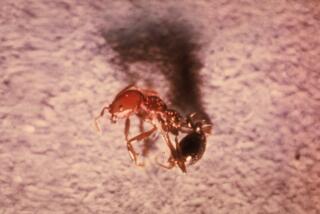FILLMORE : Insectary’s Bugs Target Citrus Pests
- Share via
The 9,000 acres of orange trees surrounding Fillmore and Piru are swarming with insects--and that’s good news to Monte Carpenter, manager of the Fillmore Insectary. Servicing the pest-control needs of the 350-member Fillmore Citrus Protective District, the insectary has raised and released 20 species of beneficial insects since 1926.
During the past 20 years, Carpenter said, less than 5% of the district’s total acreage has required insecticidal spray. Consequently, some beneficial insects, such as ladybugs and green lacewings, have stable and abundant populations. The insectary no longer raises them for release in local groves.
“The cooperation of area growers is what makes it work,” Carpenter said. Only one or two smaller orchards do not belong to the district, which means that one farmer’s beneficial insects are not endangered by the management of his neighbor’s grove.
“Any time you spray for injurious insects, you kill the beneficials as well,” Carpenter said. Orchards such as those in the San Joaquin Valley “are on a pesticide treadmill,” he added.
With five full-time workers supplemented by two part-time staff members, the insectary raises two insect predators that feed on red and black scale, the most prolific citrus pests. About 180 million beneficial insects are released annually in member orchards. Spraying is reserved for the rare, heavy infestation that defies biological control.






